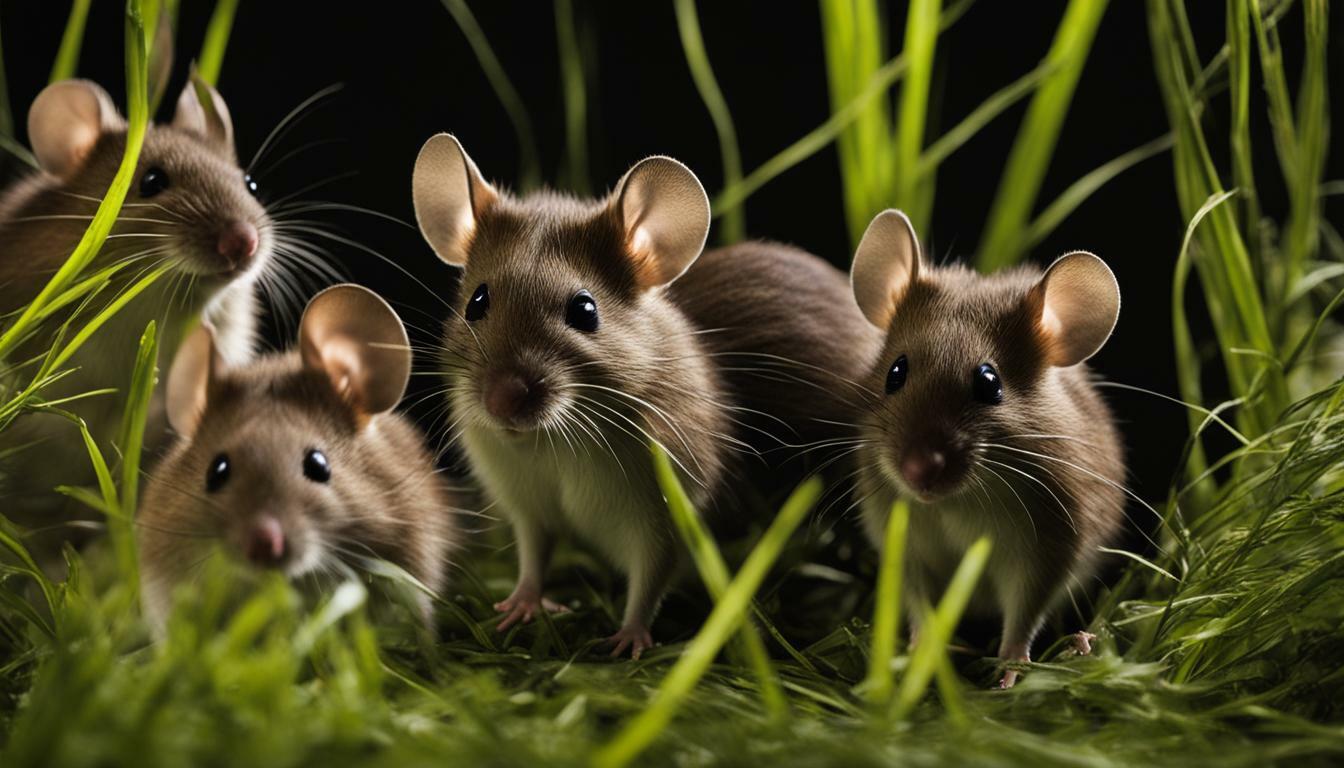Mice have a fascinating way of communicating with each other that involves vocalizations, urine, and body language. They use a combination of these methods to convey important messages and establish social bonds within their colonies.
Key Takeaways:
- Mice use vocalizations, including ultrasonic sounds and songs, to communicate with each other.
- Urine containing pheromones is used by mice to convey information about mating readiness and territorial boundaries.
- Body language, such as grooming and dominance behavior, is another form of non-verbal communication among mice.
- Understanding mouse communication methods can be useful for effective rodent control strategies.
Vocalizations: The Secret Language of Mice
Mice communicate through a secret language of vocalizations, using ultrasonic sounds and songs that are beyond human hearing. These unique vocalizations play a crucial role in their social interactions and overall communication within their colonies.
Ultrasonic vocalizations (USVs) are one of the primary ways mice convey messages to each other. These high-pitched sounds, above the range of human hearing, are emitted by mice to communicate various emotions, such as fear, aggression, or pleasure. They serve as a means of expressing their intentions, warning others of potential danger, or establishing social bonds.
Another fascinating aspect of mouse vocalizations is their use of songs. Mice sing songs to transmit messages between mother mice and their pups or to attract potential mates. These songs are specific and unique to each individual, much like a signature tune, allowing mice to identify one another and strengthen their social bonds.
| Types of Mouse Vocalizations | Description |
|---|---|
| Ultrasonic Vocalizations (USVs) | High-pitched sounds beyond human hearing used for communication. |
| Mice Songs | Songs transmitted between mother mice and their pups or to attract mates. |
Understanding the intricacies of mouse vocalizations opens a window into their hidden world of communication. By decoding their secret language, researchers gain insights into mouse behavior, social hierarchies, and even potential applications in rodent control strategies.
The Power of Pheromones: Mice Talk Through Urine
Mice rely on the power of pheromones in their urine to communicate messages about mating and territory to their fellow mice. These chemical signals, undetectable by humans, play a crucial role in their social interactions and survival strategies.
When a female mouse is ready to mate, she releases pheromones in her urine to signal her availability to nearby males. This scent marks her as receptive and helps attract potential mates. The male mice, in turn, produce their own pheromones to communicate their interest and readiness to mate. By detecting these chemical signals, mice can effectively coordinate their reproductive behaviors.
In addition to mating, mice use urine and pheromones to mark their territories. By leaving small amounts of urine in strategic locations, they establish boundaries and communicate ownership to other mice. This territorial marking serves as a warning to intruders and helps maintain social order within their colonies.
| Pheromone Signaling in Mice | Mating | Territorial Marking |
|---|---|---|
| Female mice release pheromones in urine to signal mating readiness | Male mice produce pheromones to communicate interest and readiness to mate | Urine marking establishes territorial boundaries and communicates ownership |
This reliance on pheromones and urine communication highlights the importance of these chemical signals in the social lives of mice. Understanding the role of pheromones can provide valuable insights for rodent control strategies, enabling more effective approaches to managing mouse populations and minimizing their impact on human environments.
Body Language: Non-Verbal Communication Among Mice
In addition to vocalizations and urine, mice also communicate through intricate body language, including grooming rituals and displays of dominance. Through these non-verbal cues, mice are able to establish social bonds and maintain order within their colonies.
Grooming is a significant form of body language among mice. It serves multiple purposes, including bonding, stress relief, and hygiene. Mice engage in mutual grooming, where they meticulously clean each other’s fur using their teeth and paws. This behavior not only promotes social cohesion but also helps to spread scent from one mouse to another, reinforcing their group identity.
Dominance behavior is another essential aspect of mouse body language. Mice establish hierarchy within their colonies through various displays of dominance. These displays can include aggressive behaviors like chasing, biting, or lunging at subordinate mice. Dominant mice may also puff up their fur, arch their backs, or stand on their hind legs to assert their authority. These signals are crucial for maintaining social order and preventing conflicts.
| Types of Mouse Body Language | Description |
|---|---|
| Grooming | Meticulous cleaning of fur using teeth and paws to bond and spread scent |
| Dominance Behavior | Displays of aggression, such as chasing, biting, and posturing, to establish hierarchy |
Understanding mouse body language is vital for anyone dealing with mice, whether it’s in a research setting or for rodent control. By recognizing and interpreting their non-verbal cues, it becomes easier to assess their behavior and overall well-being. This knowledge can also inform effective rodent control strategies, as it helps to identify potential breeding pairs, detect signs of stress or aggression, and implement measures to discourage unwanted mouse activity.
Understanding Mouse Communication for Rodent Control
By gaining a deeper understanding of mouse communication, we can develop more effective strategies for controlling and preventing rodent infestations. Mice use a combination of vocalizations, pheromones, and body language to convey important messages within their colonies. By decoding these communication methods, we can gain valuable insights into their behavior and take proactive measures to keep them at bay.
One of the key ways mice communicate is through vocalizations, particularly ultrasonic vocalizations (USVs). These high-pitched sounds, beyond the range of human hearing, serve various purposes. For instance, mother mice use USVs to communicate with their pups, guiding them and ensuring their safety. Male mice also sing songs to attract potential mates. By understanding these vocalizations, we can identify signs of mouse activity and take immediate action to mitigate the risk of infestation.
Another crucial method of mouse communication is through urine and the pheromones it contains. Mice use urine to mark their territories and convey information about their mating readiness. By strategically placing rodent control measures in areas marked with urine, we can disrupt their communication network and deter them from entering our living spaces.
Body language, such as grooming and dominance behavior, also plays a significant role in mouse communication. Grooming is not only a means of maintaining hygiene but also a way for mice to bond with their colony mates. Additionally, dominant mice display certain behaviors to establish their authority within the group. By recognizing these non-verbal cues, we can gain insights into the social dynamics of mouse colonies and implement targeted control measures accordingly.
| Mouse Communication Methods | Rodent Control Strategies |
|---|---|
| Vocalizations | Listen for ultrasonic vocalizations and take action if detected. |
| Pheromones | Target areas marked with urine for effective rodent control. |
| Body Language | Observe grooming and dominance behavior to understand mouse dynamics and inform control measures. |
In Conclusion
In conclusion, mice have a complex communication system that involves vocalizations, urine, and body language, and understanding these methods can help us better understand and manage these small but highly communicative rodents.
Vocalizations play a crucial role in mouse communication, with ultrasonic vocalizations (USVs) being a significant part of their secret language. These high-pitched sounds, beyond the range of human hearing, serve as a means for mice to convey messages to one another. Mice even have songs that they use to communicate with their offspring and attract potential mates.
The power of pheromones cannot be underestimated when it comes to mouse communication. Mice use urine, which contains pheromones, to share essential information about mating readiness and territorial boundaries. By marking their territories, mice are able to communicate their presence and establish dominance within their colonies.
Body language is another important aspect of mouse communication. Through grooming behaviors, mice not only maintain their hygiene but also establish social bonds with their colony mates. Additionally, dominant mice use body language to assert their authority and maintain their position within the group.
Understanding mouse communication methods is crucial for effective rodent control. By knowing how mice communicate, we can develop strategies that disrupt their communication channels and discourage their presence in our homes or places of business. Through a combination of removing attractants, sealing entry points, and utilizing deterrents, we can manage mouse populations more effectively, reducing the risks they pose and preserving our environments.
FAQ
How do mice communicate with each other?
Mice communicate through various methods, including vocalizations, urine, and body language.
What are ultrasonic vocalizations (USVs)?
Ultrasonic vocalizations are high-pitched sounds that mice use to communicate with each other. Humans cannot hear these sounds.
Do mice sing songs?
Yes, mice sing songs to transmit messages between mother mice and their pups or to attract mates.
How do mice use urine to communicate?
Mice use urine containing pheromones to convey information about mating readiness and territory marking.
Can mice communicate through body language?
Yes, mice communicate through body language, such as grooming, to bond with colony mates or establish dominance.
Why is understanding mouse communication important for rodent control?
Understanding mouse communication methods can help with effective rodent control strategies.




